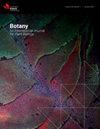苏铁生殖物候的时间变化:一项在Ceratozamia的比较研究
IF 1.3
4区 生物学
Q3 PLANT SCIENCES
引用次数: 0
摘要
植物的生殖物候由导致繁殖成功的连续生命周期阶段组成。在种子植物中,苏铁和其他雌雄异株群体具有复杂的生殖系统,其中个体需要在同一物种的两性和种群中同步。本文对三种地理上相近的苏铁(Ceratozamia)种的物候进行了分析。我们描述了花粉和卵球的寿命及其在个体发育过程中的形态变化,并评估了生殖事件之间的同步性,重点研究了受花期和开放花粉期的时间和丰度。结果表明,三种植物的生殖时间高度同步,受花期和开放花粉期的重叠可能表明不同物种群体之间存在基因流动。我们确定了繁殖模式与温度和降水制度之间的相关性。花粉和卵花在雨季产生,而接受性和花粉的同步期发生在旱季。种子释放发生在雨季,这有助于保持种子湿润,防止胚胎干燥。最后,我们强调了野生种群研究对苏铁物候模式的生态和进化理解的效用。本文章由计算机程序翻译,如有差异,请以英文原文为准。
Temporal shifts in reproductive phenology of cycads: a comparative study in Ceratozamia
The reproductive phenology in plants consists of successive life cycle phases leading to reproductive success. In seed plants, cycads and other dioecious groups have complex reproductive systems, where individuals require synchronizations among two sexes and populations of the same species. Here we analyzed phenology between populations of three geographically close species in the cycad genus Ceratozamia. We described the lifespan of pollen and ovulate strobili and their morphological changes throughout ontogeny and evaluated synchrony among reproductive events, focusing on the timing and abundance of the receptivity and open pollen phases. Our results showed that the reproductive timing in the three species was highly synchronous, and that the overlap between the receptivity and open pollen phases could point to gene flow among populations of different species. We identified a correlation between the reproductive patterns and the temperature and precipitation regimes. Pollen and ovulate strobili were produced during the rainy season, whereas the period of synchrony between receptivity and pollen occurred during the dry season. The seed release occurred during the rainy season, which could contribute to keep the seed moist and prevent the embryo from drying out. Finally, we highlight the utility of studies in wild populations for the ecological and evolutionary understanding of phenological patterns in cycads.
求助全文
通过发布文献求助,成功后即可免费获取论文全文。
去求助
来源期刊

Botany
生物-植物科学
CiteScore
2.20
自引率
9.10%
发文量
48
期刊介绍:
Botany features comprehensive research articles and notes in all segments of plant sciences, including cell and molecular biology, ecology, mycology and plant-microbe interactions, phycology, physiology and biochemistry, structure and development, genetics, systematics, and phytogeography. It also publishes methods, commentary, and review articles on topics of current interest, contributed by internationally recognized scientists.
 求助内容:
求助内容: 应助结果提醒方式:
应助结果提醒方式:


